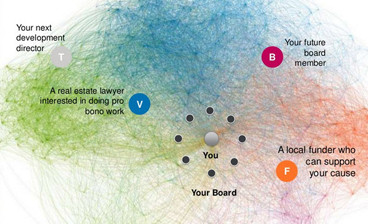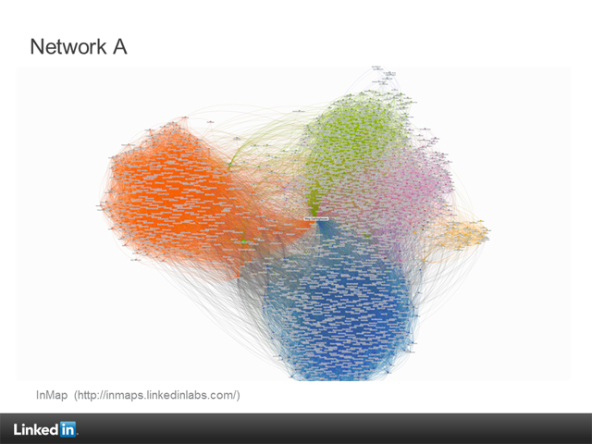One of my first jobs in the nonprofit sector over 30 years ago was serving as the executive director of a small nonprofit called the Pro Arte Chamber Orchestra, where I was responsible for many areas, including managing our board. One of the hardest tasks was identifying, cultivating, educating, and recruiting new board members.
Luckily, we had a strong network of people involved with the orchestra—the musicians, board members, audience members, and volunteers were united by a love for classical music. To tap into the network (and this was before nonprofits had Internet connections), I circulated a network inventory survey to collect and organize the contacts of everyone in this network.
I was able to record (on color-coded, 3-by-5-inch cards) our collective contacts, what networks they belonged to, and what skills and connections they could bring to our board and organization. Using the cards, we created social network maps of our collective contacts as part of strategizing for board recruitment. The network became a valuable resource for governance, and also helped us fundraise, put on concerts, offer pro bono services, and more.

Today, if I were a nonprofit CEO, I might turn to LinkedIn Board Connect, a new resource that can help nonprofits transform themselves into networked nonprofits by finding and recruiting board members using a networked strategy. It provides free access to a premium LinkedIn feature that lets you search for and connect with professionals who meet the needs of your organization—it’s much like my 3-by-5 card system, but far more efficient and powerful.
Are you enjoying this article? Read more like this, plus SSIR's full archive of content, when you subscribe.
The idea is simple. You and your board look at your professional networks and connections on LinkedIn. Board Connect lets you zero in on the people who have the right networks and knowledge for your nonprofit. You can contact them through LinkedIn, and the interface has tools to manage your search.
What does the traditional board development process look like? Typically, there is a discussion like “We need someone who has [fill in the blank] skills.” Then everyone on the board development committee goes through their mental Rolodex to come up with a list of potential candidates. Next is the screening process that sometimes can require abilities akin to an investigative reporter’s. Using an online social network puts the process on steroids.
On LinkedIn, you can see past first connections, and check out a potential candidate’s knowledge and their network. If all board members add their networks, this produces a richer set of potential candidates. And, remember, you are not just adding a board member to your team—you are also adding their network.
While online networks can actually make your organization’s journey through the board development process more efficient, your organization needs to bring a network mindset to a board search that goes beyond the traditional recruitment process. This is the only way to find the best people available; it also expands the diversity and reach of your network. Your board search does not have to get stuck in the first-connections of senior staff and fellow board members if you can complement the “who do you know” question with online social networks tools and mapping.
Using social network mapping tools
 (Illustration from “Measuring the Networked Nonprofit” and created by Rob Cottingham)
(Illustration from “Measuring the Networked Nonprofit” and created by Rob Cottingham)
To start thinking in terms of a network versus “Who do we know who has this skill?”, create a social network map of your board members’ and staff’s networks. It can help you see where the “holes” and “silos” are in your network, and help you reveal new networks and people to connect with to reach your goals.
The value of mapping your network is that it makes otherwise invisible relationships visible. Social network maps provide a guided tour through the social landscape of the people, skills, relationships, and organizations in your network. Using them, you can visualize and explore patterns that can help your organization’s effectiveness.
As Meg Garlinghouse points out in her post, “Why Connections Between Nonprofit Leaders and Board Members Matter,” the nonprofit sector tends to be very connected with each other but not with the business world. Having a visualization of your professional network in the form of a social network map can help you or your board play the role of “network weaver” by connecting to a whole new set of resources in the form of knowledge (skilled volunteers), donations (potential donors or corporate partners), and connections (future board members).
You can see how to implement this strategy using LinkedIn InMaps tool, an interactive visualization of your professional connections that enables you to see relationships between people in your network. It can help formulate a board strategy the helps you identify and bridge gaps in your networks.
If your network looks like Network A, or “flower,” or if it has distinct clusters, your organization should identify and invest in some relationships outside of these clusters. This is called “filling structural holes in your network,” but if you can reach out to new nodes and clusters, you will more successful in finding new resources and ideas.

If your network looks like a virus, or has lots of well-connected nodes and density, so that there are no clearly defined “silos,” that’s good. Here, many people are connected to many people—and this is a good thing. If one connection drops out, there are redundant connections. And, with such a density of connection, it opens the door for more resources or different ways of thinking.

If you combine a network mindset with social networking tools, you and your board can recruit both the best talent to join your board and the people with the best networks. Having a robust, well-connected network can help your nonprofit find new resources, get new ideas and inspiration, and be more effective.
Is your nonprofit strategizing about how its networks can leverage social change? Does your nonprofit have a successful story about leverage its board network? Have you used social network maps to inform your strategy?
Support SSIR’s coverage of cross-sector solutions to global challenges.
Help us further the reach of innovative ideas. Donate today.
Read more stories by Beth Kanter.

